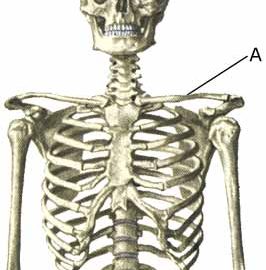|
||
|
||
| Cause: A fracture of the collar bone can occur in cases of a direct fall on the shoulder, or fall upon an outstretched arm; this is one of the most common fractures (5-10% of all fractures). The ligaments holding the collar bone in place may also rupture.
Symptoms: Pain in the collar bone and upon movement of the shoulder joint. In cases of a fracture with displacement of the bone, a bump is often visible on the collar bone. Treatment: Depending on the type of fracture, rest and possibly a sling may be employed until pains decrease after a couple of weeks. In some instances, a sling is chosen to fixate the fracture (Madsens figure-8 bandage). In more complex fractures, and fractures with ruptured ligaments a surgical fixation of the fracture is most often chosen. In some cases it is an option to fixate certain fractures with a plate, which allows a faster return to sports, but the operation has a relatively high risk of complications (article). Rehabilitation: When the pain has diminished (after 2-3 weeks) physical fitness training in the form of running may be commenced, and retraining according to the guidelines under rehabilitation of children and adolescents in general. After 4-6 weeks careful muscle training of the shoulder muscles may be started. Participation in contact sports will be possible after a couple of months have elapsed. Complications: In the vast majority of the cases the fracture will heal without complications, although some suffer long-term discomfort, even if the fracture heals. Some fractures form a false joint (pseudoartrosis), which requires (renewed) surgery. |


